“There’s no place like home.”
The Classic Movie Blog Association is hosting a Films of 1939 Blogathon this weekend. Being the classic film nerd that I am, I couldn’t not participate in this one. Some of my favorite films of all time were released in 1939, and over the next two days I’ll be talking about a few of them right here at vivandlarry.com. So sit back, relax, and enjoy. And definitely head over to the CMBA (linked above) to check out the other entries!
There are certain films that stick with us throughout our lives. Films that we fall in love with as a child and remember just as fondly years down the road. These films are ones we find ourselves reaching for on a rainy day, or when we feel nostalgic about the past and want to recapture something of the lost magic of childhood. These are tried and true classics, no matter how old the film itself is.
The Wizard of Oz has always been my constant. I remember that I was 7 years old the first time I saw Victor Fleming’s 1939 fantasy epic. In fact, I know I can dig up an old photo of me dressed as Dorothy Gale for Halloween. My parents bought a VHS copy for my younger brother and I at Disneyland back in the early 90s. I remember watching it several times growing up, and it’s a film I can still quote at length. There’s something magical about Oz. Like many classic Hollywood films of its time, its themes are universal. The ideals present in the story–searching for a place “beyond the rainbow” where troubles are left behind only to realize that home is where the heart is–were poignant to Depression-era audiences. And they still apply today.
“It’s not a place you can get to by boat or by train. It’s somewhere far, far away–behind the moon, beyond the rain.”
The Wizard of Oz has been one of the most well-known American fantasy stories for over a century. L. Frank Baum published the first book in his series, The Wonderful Wizard of Oz, in 1900. 12 other books followed over the next 20 years. The original book was turned into a stage production that traveled America in 1902 and 1903. Advances in the new cinematic medium at the time led Baum to establish The Oz Film Manufacturing Company, under which he produced silent film versions of his own books. None of these films were successful. It was in 1938, after the success of Disney’s Snow White and the Seven Dwarves proved popular, that The Wizard of Oz was again seriously considered as a film adaptation. This time it fell into the hands of MGM producer Mervyn Leroy, who purchased the rights from Samuel Goldwyn. The job of director fell into the hands of MGM contract director Victor Fleming (who would leave the shoot toward the end of filming to take over on Gone with the Wind).
“I don’t think we’re in Kansas anymore.”
There is so much about this film that has become iconic–namely Judy Garland, Over the Rainbow, the ruby slippers, the overly-quotable dialog that has been referenced countless times in subsequent films, etc.–but I think there is still more to it . One of the most impressive aspects of The Wizard of Oz is its technical achievements. Documentaries about the film have revealed the artistry behind A. Arnold Gillespie’s special effects (the tornado that sweeps Dorothy and the Gale home off to Oz, or the pink bubble that brings Glinda to Munchkin Land, for example) but my favorite part has always been the contrast between sepia-toned Kansas and the Technicolor glory of the Land of Oz. The scene when Dorothy opens the door to her sepia-toned room and reveals Munchkin Land bathed in bright color has got to be one of the most brilliant sequences in any film. I still marvel at little things such as the Horse of a Different Color (clever post-production coloring) and admittedly sometimes still find myself questioning whether the flying monkeys are people in scary monkey suits or something else entirely (seriously, what are those things?).
The doorman: “Can’t you read?”
Group: “Read what?”
The doorman: “The notice!”
Group: “What notice?”
The doorman: “The one on the door. It’s as plain as the nose on my face!”
Technicalities aside, what drives the film is the performances (and the songs that go with them!). I know Judy Garland deservedly gets most of the credit, and I think she does a wonderful job, but I’ve always preferred Margaret Hamilton as Ms. Gultch/The Wicked Witch of the West and Frank Morgan (my favorite bit player in classic cinema) as Professor Marvel, the cabbie, the doorman, the guard, and of course, the wonderful Wizard of Oz himself. These two do not get much screen time compared to Garland, Ray Bolger, Jack Haley and Burt Lahr, but to me they leave the biggest impact. Hamilton has become the prototype for the image of the wicked witch in popular imagination, and I think we secretly all want Frank Morgan to be our grandpa. Of Dorothy’s three companions, the Scarecrow has always held a special place in my heart. I think he gets the best lines, such as “Some people without brains do an awful lot of talking.” And his dance moves would have given Michael Jackson a run for his money.
“I’ll get you, my pretty. And your little dog, too!”
A couple of years ago, I had the opportunity to see The Wizard of Oz on the big screen at the AMPAS Samuel Goldwyn Theatre in Beverly Hills as part of the Academy of Motion Pictures’ tribute to the best picture nominees of 1939. The celebration of 10 films was bookended by the two films that continue stand as beacons representing the classical Hollywood era, and indeed, films in general. While I missed the Gone with the Wind screening, I did make a point of going to see Oz and it was well worth the trip. The theatre was packed with film lovers young and old. Judy Garland’s grandchildren were in the audience, and one of the last remaining Munchkins, Jerry Marin (whom you may know as the green member of the Lolipop Guild who hands Dorothy a giant lolipop) was invited up onstage to share his memories of working on one of the most beloved films of all time. In the film, Marin can be spotted in many of the Munchkin Land shots, perhaps getting more screen time than any of his fellow Singer Midgets. Apparently Victor Fleming got a kick out of him. Like Gone with the Wind, Oz was meant to be seen in a theatre rather than on a small tv screen.
The AMPAS screening of 2009 was also memorable for displaying props and other artifacts from the film that are stored in the Academy Archives. These included Burt Lahr’s Cowardly Lion wig and Judy Garland’s miniature Oscar for best juvenile screen performance of 1939. Being the history nerd that I am, it was wonderful to get to see these timeless treasures up close and personal. Below are come of the photos I snapped in the Goldwyn lobby.
Bert Lahr’s Cowardly Lion wig
Judy Garland’s Oscar for the best juvenile performance of 1939
Original lobby cards and promotional materials
The Wizard of Oz, like Gone with the Wind and other films that have withstood the test of time, is a film I will show my children and grandchildren. There’s something in it for the young and the old, and I think that’s what makes this film so special.


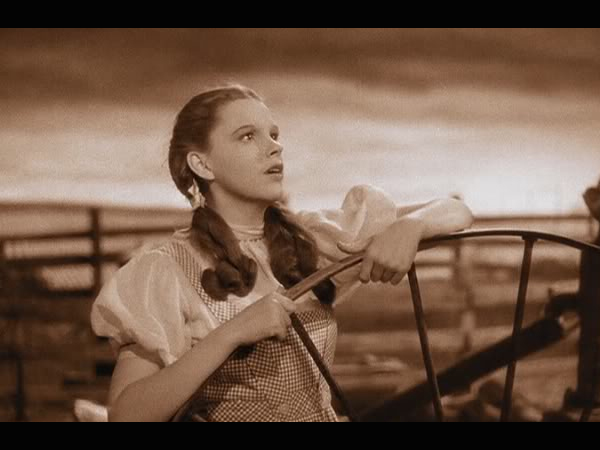
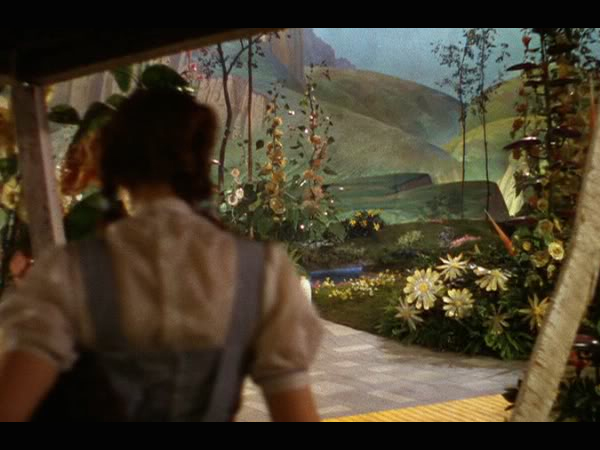
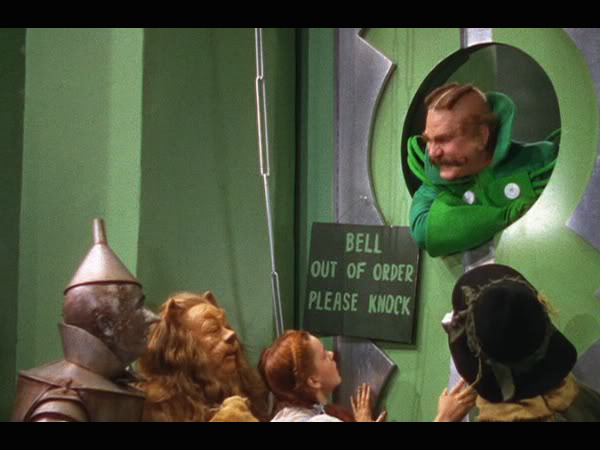
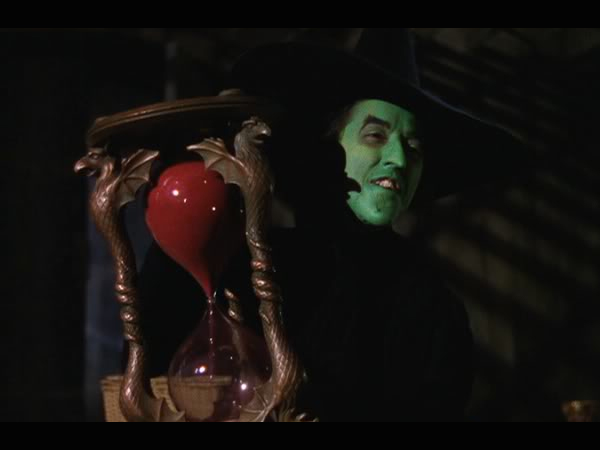
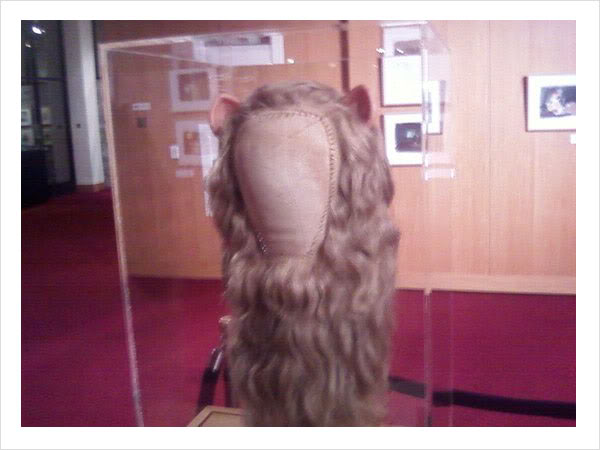
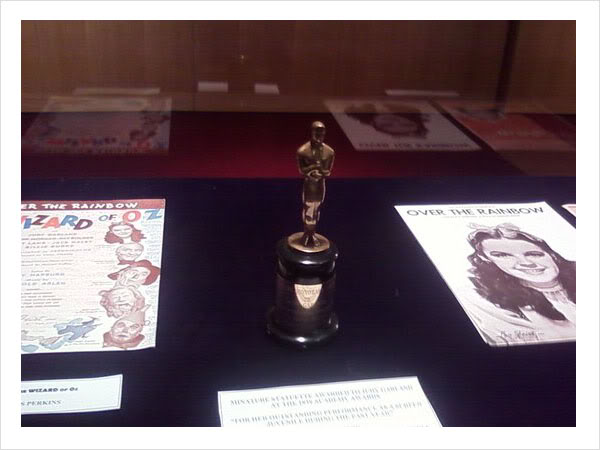
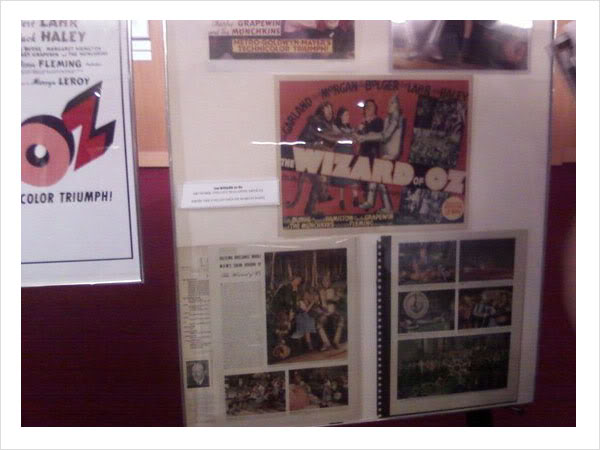

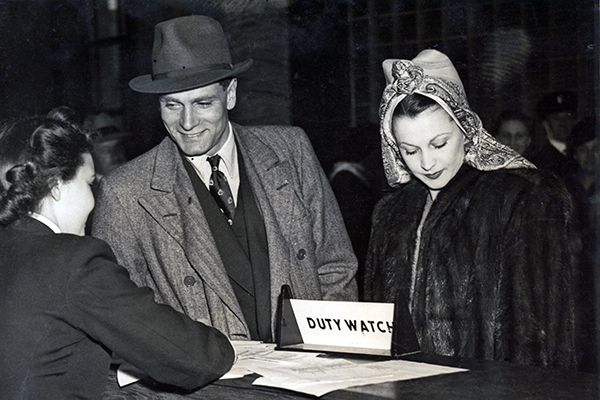



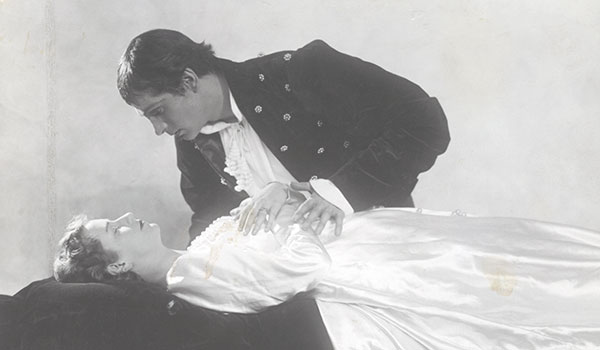
What a lovely write-up on this eternally golden movie; really enjoyed reading it! The fact that The Wizard of Oz has withstood the test of time so well is the true testament to its greatness, which is of epic proportions.
Thanks, Riikka! I agree, it’s funny how this film and Gone with the Wind were released in the same year by the same director, and they remain the most beloved movies in film history
Loving and well-written review of perhaps the most iconic film in Hollywood history. The photos are awesome! I’ve also had the marvelous experience of watching it on the big screen. By the way, Baum wrote 14 Oz books and was credited with a 15th. Ruth Plumy Thompson wrote 19 more books in the official Oz series. No 1939 classic film blogathon would be complete without an Oz review!
Thanks, Rick! I think seeing this and other similar films from the period on the big screen is definitely the way to go!
The wonderful thing about The Wizard of Oz is that it still has the power to delight brand new audiences…more often than not comprised of younger folk who are a bit jaded by older movies because they’ve been exposed to films with CGI and other special effects noise. My niece Rachel positively adores the movie, and one of the biggest treats for the two of us is sitting down and watching it whenever it’s on–like you, she also did the Dorothy Gale masquerade for Halloween (much to my sister’s dismay, who said to me: “I’m not even going to tell you what I paid for that basket the dog sat in”). Film historian Danny Peary once mused that it’s possible every film since Oz’s release references it in some way (from “A” [Alice Doesn’t Live Here Anymore] to “Z” [Zardoz]) and I’m not entirely sure he’s wrong on this. It’s always been my choice for best and favorite film from that amazing year.
I’ve never thought about Oz being referenced in every film since, but it does seem to have been referenced more than any other movie I can think of. If that doesn’t attest to its status in pop culture, I don’t know what does!
Kendra, your blog post about THE WIZARD OF OZ was a joy to read! Your genuine affection for this ever-timeless film shines in every word. Having loved …WIZARD… since my own childhood, I can tell you from experience that every kid (of all ages :-)) with whom I’ve ever watched it ended up adoring it no matter how jaded they thought they were. They didn’t need CGI to enjoy it, either! 🙂 And lucky you, actually having the chance to see …WIZARD… on the big screen at the AMPAS Samuel Goldwyn Theatre! Thanks for sharing your feelings and experiences about this classic with all of us!
Thanks so much, Dorian! I’ve introduced it to a few people, as well (although not children, adults) who also loved it. Screw CGI. Some of these films did plenty well without it! 🙂
Kendra, beautifully written and very interersting review. When I was a kid, lo these many moons ago, the Wizard of Oz was shown on TV once a year. We always watched it. We had a black and white TV, and do you know it wasn’t until I was about 12 that we got a color TV and I knew that Oz was in color! My Dad said he didn’t tell us because he and Mom wanted to save up for a color TV and let us experience it ourselves! What a surprise!
I too was able to see it on the big screen, and what a difference! So many things you just cannot really see on the TV. It’s a marvelous movie, and I’ll always love it. Wonderful contribution to the blogathon, Kendra. A-One!
Thanks! My mom has a similar story of seeing films like Oz on a black & white tv, only to realize later that they were filmed in color!
I find seeing old films on the big screen to be much more enjoyable. Part of it is because when sitting in a theatre one is forced to pay closer attention to the film than one would be if, say, watching it on a laptop with countless distractions at hand.
Heh, I just watched this yesterday to review the 3-Disc Collector’s Edition. Isn’t that scene transition between the sepia and the technicolor just… breathtaking?
Awesome! That’s one of my favorite DVD sets! It really is a breathtaking scene
Wizard of Oz is an example of a film that has far supplanted the book on which it was based in the public consciousness. I read a recent web article about great children’s books, and in the section about Wizard of Oz, it was plain the writer had never read the book, as she was summarizing the film.
The two most memorable themes from the film are nowhere in the book. First off, when the crew comes to ask for brains, courage and a heart, the wizard GIVES their desires to them – there’s no “you had it all along” to be seen.
And more importantly, i the original book, Dorothy’s adventure absolutely HAPPENED. No dream after a blow to the head, she returns several days after the tornado, telling everyone about the land of Oz.The film had a very isolationist message to it; adventures are nice, but rather than go off looking for your dreams, stay home and prune the tomatoes.
I’ve never read the books, so it’s interesting to hear what was put in or left out. Thanks for sharing!
It was a pleasure to read your personal thoughts and the interesting information on “The Wizard of Oz”. I’ll admit to always tearing up at the dedication in the opening credits, but I do recover in time to enjoy the movie.
I love the dedication at the beginning, as well. Well done, MGM, well done! 🙂
Thanks for your lovely review of a timeless and wonderful classic – The Wizard of Oz has true magic, and I always feel thankful that it was made, and with such care and quality – Truly, some films will never grow old!
I agree, some films really never do grow old. It’s one I don’t think I’ll ever quite outgrow!
heck yes margaret hamilton! she really was wonderful. and getting to see the real deal up close and personal is always amazing, especially when attached to something treasured in childhood and beyond.
It’s true. I’m glad I got to see it on the big screen!
Kendra, I won’t comment on the movie itself. I wouldn’t know where to begin or when to stop! But I will say how much I enjoyed your very personal approach to writing about this movie that I’m sure is special to all moviegoers, not just fans of classic movies. I especially liked your account of seeing it on the big screen and the photos of the memorabilia on display. If I were to speculate on the reason for the enduring popularity of “The Wizard of Oz,” I would say that it is above all its hopeful message for everyone who has ever felt alone or misunderstood. Who hasn’t? I suppose that’s what’s meant by universality in art.
Thanks very much, R.D.! I think you’re right about the film’s hopeful message. It’s one that applies to people of all ages and walks of life!
I loved your post, Kendra! It’s nice you shared your experience watching this classic film on the big screen. Congrats 🙂
Thanks, Clara!
A very informative and fun read on one of our most iconic films..
It’s fantastic that you had the opportunity to see it on the big screen. And I love that you included some memorabilia for us.
Page
Thanks! Seeing old films on the big screen is really the best way to see them, I think!
Kendra, this was truly lovely. It is fitting that such a magical film received such a magical tribute Beautiful!
Thanks!
Wonderful review and personal remembrances. I think this is a film that is personal to anyone who watched its annual airing when they were growing up. Who knew back then I would love film as I do now? I certainly didn’t realize I was watching a classic then, but 40 years later I still think of that movie every spring. And, growing up in a small town, that movie is one reason I have a fear of tornadoes!!
Thanks, Brian! I think everyone is like that with films from childhood. Some of them are particularly close to our hearts for a while before we outgrow them while some last for ages and ages! I don’t blame you for fearing tornadoes, lol 🙂
Kendra, You did a wonderful job on one of the most beloved of all American movies. Possibly the most timeless of all. Your appreciation and affection shine through with every word. Must’ve been a great experience to see “The Wizard of Oz” on the big screen at the AMPAS theater – plus the chance to see all that wonderful memorabilia – I love Bert Lahr’s Cowardly Lion wig. Thinking about all of the wonderful films of ’39, I’d have to say this is one that is flawless perfection.
Thanks! AMPAS screenings are always fun, and they always have good exhibitions, too! It is pretty flawless, isn’t it? Love it!
Hi Kendra … Another great post, as always. I love it that you singled out Margaret Hamilton for special mention … she was so good in this role. You might find it amusing to know that when I was a kid back in the 70’s, Margaret Hamilton used to be featured in TV commercials for coffee! That the old girl could sell coffee to the masses after frightening the wits out of them for decades says something about her versatility as an actress, I think!
As a child, “THE WIZARD OF OZ” was my favorite movie until I discovered GWTW at the age of 14. Unfortunately my obsession with that and all things Vivien prevented me from seeing it for many years or giving it much thought. But I watched a remastered version on DVD recently and was quite blown away by it all over again. I’m certainly not a “Judy Garland fan” in the same sense that I am of Vivien, although I do think she was phenomenally talented. But I don’t think enough praise or credit can be given her for her performance in this film. Not only was she one of the most gifted singers EVER, I think she had to be one of the all-time greatest natural actresses. The sincerity and believability she brings to this role is nothing short of astonishing. As with Vivien in GWTW, it is impossible to envision anyone but Garland as Dorothy Gale. She reportedly gave much credit to director George Cukor for helping her develop her characterization. It’s often noted that Victor Fleming got directorial credit for both “OZ” and “GWTW”, but when you consider how Cukor helped shape the performances of the leading actresses of both films (with no film credit), it’s interesting.
At any rate, I always enjoy your comments on other classic films. Thanks for another great post and opportunity for discussion about them!
Thanks, David! Lara over at Backlots posted the Margaret Hamilton Maxwell House. It was amazing! Quite like Olivier selling Polaroid cameras in the 70s!
My favorite movie before GWTW was Titanic. It was all the rage when I was 14. I have never read about Cukor shaping Garland’s performance, but I have heard that he stopped by the set for a couple weeks and sorted out Dorothy’s look with her hair and make-up.
Hi Kendra — With regard to Cukor sorting out Dorothy’s “look” … thank heavens he did! From the photos I’ve seen it was just awful! As far as helping Garland develop her characterization, I didn’t mean to imply that he did nearly as much for her as he did for Vivien … I don’t think he continued to coach her behind the scenes or anything. But I did read that before Cukor got hold of her, Garland’s performance was as artificial as her make-up, and his biggest contribution was to encourage her to “be herself” and “play it straight”. Supposedly Garland was very grateful, and that is why Cukor was her first choice to direct her in the 50’s remake of “A Star Is Born”. All this according to an old book I’ve got on the subject from 1989 called “THE WIZARD OF OZ: The Official 50th Anniversary Pictorial History” by authors Fricke, Scarfone, & Stillman. It’s a good book … I hadn’t looked at it for years until your blog inspired me to read further on the subject!
PS: On a different topic, I’m currently in the middle of reading the new book about Margaret Mitchell and the creation of GWTW, and it’s riveting! I think you’d enjoy it.
Kendra – Your personal touches and stories are fascinating. The opportunity to see a classic film on the big screen is always a special treat and getting to see the OZ artifacts is a WOW moment! I remember Margaret Hamilton just scaring the hell out of me as a kid (many years ago) in the film.
Haha, thanks! Margaret Hamilton is quite scary in the film!
Of all the great movies that came out in 1939, I think this movie is the most enduring. A lot of people I talk to about this movie can not believe it came out in 1939. It is a true timeless classic!
I would say this one and GWTW are tied for most enduring. But it really is a true classic, and with the great Warner Bros. restoration recently, it looks better than ever!
Mutliple times recently I have marveled at how prominent Wizard of Oz is in today’s society. I think about how that movie came out before my PARENTS were born and yet I consider it a family movie from my youth. I’m sure I’ll show it to my kids and it will never seem out dated. How is that? I can’t imagine MGM knew at the time what they were creating and how well it would be accepted by future generations.
I think you’re right. It’s hard to imagine any films that have been released in the past 20 or so years that will endure as The Wizard of Oz has.
Like Becky, for years I knew this one only as a black and white movie. We didn’t get a color television until I was in high school, in the late 1970s.
I saw it in color for the first time when I was in college and I was blown away by the Technicolor imagery. But such is the power of the film, that even in black and white its still a magical experience.
Still, I’m glad they cut the “Jitierbug” number. It would have really slowed the film down. Sometimes less is more.
Aww, I think it would be quite a shock to suddenly discover that a film you’ve seen many times is actually totally different.
I agree about the jitterbug number. It would have slowed down the film, and I think they cut out or reshot some of Ray Bolger’s dance, as well
Very lovely post. A movie so much a part of our childhoods, I don’t suppose we can ever really separate ourselves from our childhood memories of it. I wish I could have seen it on the big screen. That must have been delightful, and powerful.
\thanks, Jacqueline! I hope you get a chance to see it on the big screen some day. It’s really a wonderful experience!
Lovely write-up, Kendra! I really like how you reflected on this film from a nostalgic point of view, as that’s how I remember it best. Some classic films we discover as adults and appreciate immediately from a technical, more grown-up perspective, but for me, as I’m sure with many people, this was probably my first exposure to classic film and really the wonder and imagination of the film medium in general. Your post really reminded me of those first childhood impressions and made me want to revisit this film for the 1000th time. Great job! 🙂